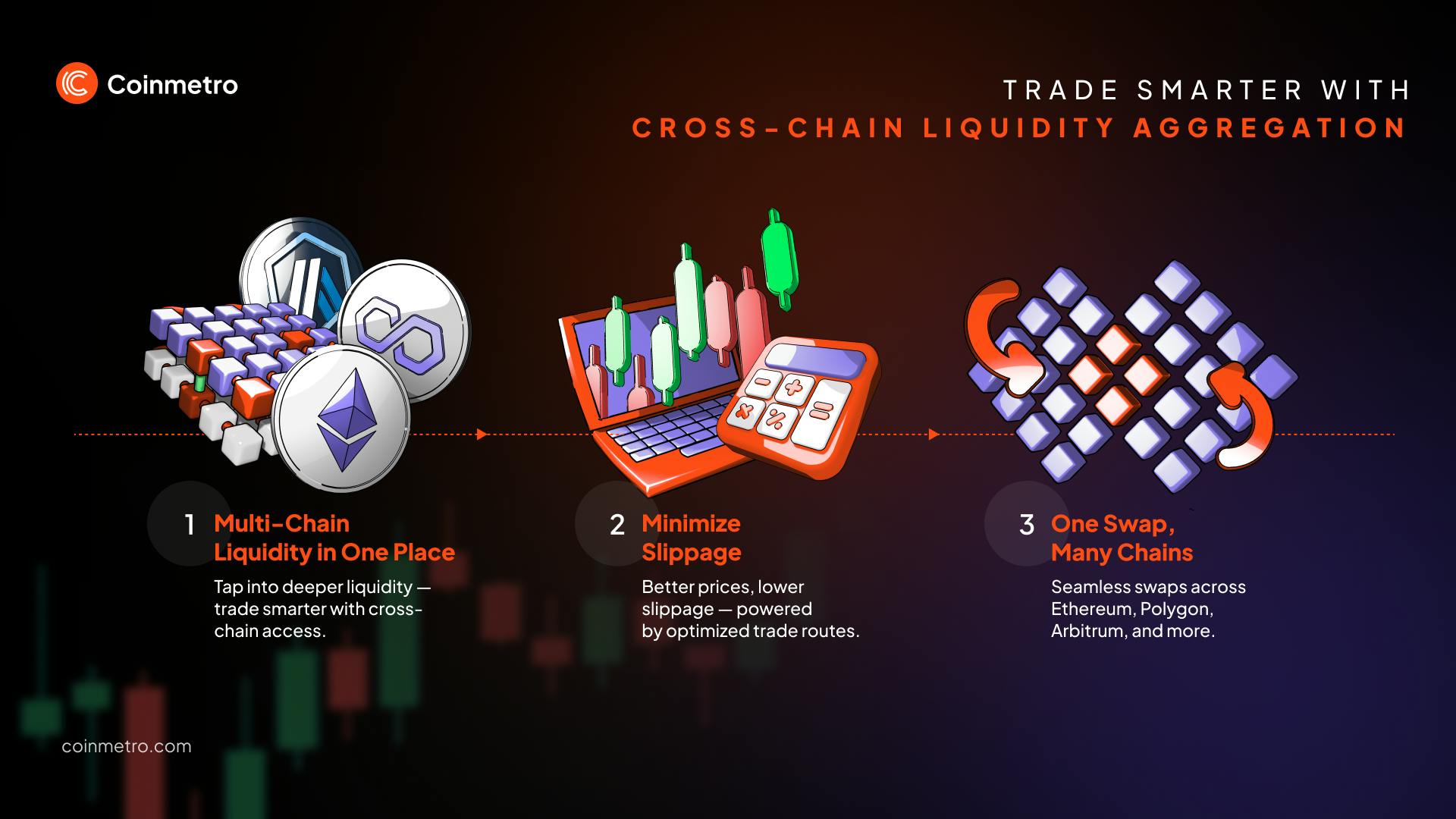Cross-Chain DEX Aggregators: Maximizing Liquidity and Minimizing Slippage
May 8, 2025

by Coinmetro
May 8, 2025
Decentralized exchanges (DEXs) have transformed trading by allowing direct peer-to-peer transfers of digital assets. They remove the need for central intermediaries and rely on blockchain architecture. This structure offers stronger transparency, data integrity, and resistance to tampering. It also minimizes custody risk. Still, DEXs face limitations. Two major ones are liquidity constraints and slippage. Both affect trading speed and execution quality.
Liquidity reflects how easily assets can be bought or sold without shifting prices. High liquidity allows large trades with minimal impact. In contrast, low liquidity leads to bigger bid-ask spreads and sharp price movements. This reduces efficiency and widens the gap between market intent and reality.
Slippage occurs when the trade execution price differs from the expected price. It typically appears in fast-moving markets or when liquidity is thin. Slippage can cut into profits, especially for larger trades or algorithmic execution strategies.
Cross-chain functionality has become essential in decentralized finance. It allows assets to move across different blockchain networks without friction. This expansion boosts overall liquidity and reduces slippage risk. Cross-chain DEX aggregators play a key role. They pull liquidity from many networks and optimize trade routing for better outcomes.
This blog will explain how cross-chain DEX aggregators maximize liquidity and minimize slippage, enhancing the trading experience in decentralized finance (DeFi). You will learn about:
- Understanding cross-chain DEX aggregators
- The role of liquidity in DEXs
- Benefits for traders and investors
- Technical challenges and solutions
- Future of cross-chain DEX aggregators
Compare: Decentralized Exchanges (DEXs) vs. Centralized Exchanges (CEXs)
Cross-chain decentralized exchange (DEX) aggregators connect users to liquidity across multiple blockchain networks. They gather trading volume from different DEXs and allow asset swaps between chains without bridges or centralized intermediaries. Their goal is to boost liquidity, reduce slippage, and improve pricing by searching many markets at once.
Traditional DEXs operate on one blockchain. This limits trading to assets native to that network. For example, an Ethereum-based DEX can only support ERC-20 tokens. That restriction fragments liquidity and increases the risk of slippage.
Cross-chain DEX aggregators solve this by linking several blockchains. Their routing engines scan for the best available trades across all connected chains. This process minimizes slippage, widens asset access, and secures better execution. By merging liquidity from multiple ecosystems, they help users trade more efficiently and at lower cost.
Several cross-chain DEX aggregators have gained prominence in the DeFi space:
Rango Exchange: Integrates over 100 DEXs and bridges, ensuring robust cross-chain transactions. The user-friendly platform supports more than 25 wallets, emphasizing efficiency and trust.
1inch: A well-established DEX aggregator that uses the Pathfinder algorithm to find optimal swap routes across numerous DEXs. It offers high liquidity, user-friendly interfaces, and governance features through the 1inch Network DAO.
OpenOcean: Excels in handling transactions across both EVM and non-EVM chains, connecting over 30 chains and sourcing liquidity from more than 1,000 providers. It offers features like no-gas limit orders and extensive multi-chain swaps, making it a versatile choice.
ParaSwap: Integrates multiple DEXs to provide efficient stablecoin swaps with low slippage. It supports several blockchains, including Ethereum and Optimism, and is known for its security and gas-efficient trading.
Matcha: Built on the 0x protocol, Matcha offers deep liquidity pools and advanced trading features. It is designed for professional traders and supports multiple blockchains, providing competitive trading fees and efficient swap routes.
These platforms are among the popular choices due to their ability to aggregate liquidity from multiple sources, optimize trade routes, and minimize slippage. They provide enhanced trading experiences through better price discovery, cost efficiency, and user-friendly interfaces, making them suitable for novice and experienced traders.

Liquidity refers to the ease with which an asset can be bought or sold in the market without affecting its price. In decentralized exchanges (DEXs), liquidity is crucial because it impacts how quickly and efficiently trades can be executed. High liquidity means ample buy and sell orders, allowing for smoother and faster transactions.
Liquidity significantly influences trading efficiency and the overall user experience:
Transaction speed: High liquidity ensures that orders are filled quickly, reducing the waiting time for traders.
Price stability: With sufficient liquidity, large trades are less likely to cause significant price fluctuations, leading to a more stable trading environment.
Lower slippage: Slippage, the difference between the expected price of a trade and the actual executed price, is minimized in highly liquid markets, ensuring traders get the prices they anticipate.
Reduced costs: High liquidity leads to narrower bid-ask spreads (the difference between the highest price a buyer is willing to pay and the lowest price a seller is willing to accept), reducing the implicit trading costs.
Cross-chain DEXs enhance liquidity by aggregating assets from multiple blockchains, providing traders with a more seamless and efficient trading environment than single-chain DEXs.
Single-chain DEXs
Limited liquidity: Single-chain DEXs, like Ethereum, operate within a single blockchain. This confines liquidity to the assets available on that specific chain, which can result in higher slippage and less efficient trades.
Fragmented markets: Traders needing to exchange assets across different blockchains must use multiple DEXs, leading to fragmented liquidity and a more complex trading process.
Cross-chain DEXs
Aggregated liquidity: Cross-chain DEXs combine liquidity from multiple blockchains, providing a larger pool of assets and enhancing the overall trading experience. Due to higher liquidity, users can access a broader range of tokens and enjoy better prices.
Seamless trading: Cross-chain DEXs facilitate trades across different blockchains, offering a smooth trading experience. Users do not need to manually move assets between chains, reducing friction and transaction times.
Optimized trade execution: Cross-chain DEX aggregators use advanced algorithms to find the best trade routes across various liquidity pools, minimizing slippage and ensuring users get the best possible prices for their trades.
As mentioned, cross-chain DEX aggregators use real-time routing to find the best prices across chains. Their algorithms scan many pools to choose the most efficient trade path. This helps reduce slippage and improves pricing accuracy. Merging liquidity lowers bid-ask spreads and makes trading more stable. Traders save money and get better results by using aggregated liquidity instead of isolated sources.
Traditional DEXs only support tokens on one blockchain. Aggregators remove that limit by connecting many networks. Users can trade tokens across chains without switching platforms or using bridges. This setup gives traders access to more assets and better opportunities. It supports portfolio growth and faster trades. Users can react quickly to price moves without moving funds manually.
Cross-chain DEX aggregators face complex technical issues that impact security and performance. These include chain-to-chain communication, protocol compatibility, and transaction risks.
Most blockchains run on unique protocols and use separate consensus methods. That makes it hard for them to share data or verify trades across networks. Without standard rules, transactions can fail or behave unpredictably between chains.
To fix this, developers use tools that act as bridges. These tools help translate and validate information between blockchains. Standardized messaging layers and routing frameworks are key to making them work together.
Moving assets between chains adds risk. Threats like replay attacks, double-spending, and smart contract bugs can potentially grow with each transfer. To stay secure, projects must audit their code and use strong encryption. Third-party reviews and bug bounties help spot issues early. Extra safety layers also reduce risk during token swaps across chains.
To address these challenges, several technological solutions and advancements have been developed:
Atomic Swaps: A cryptographic method that allows two parties to exchange cryptocurrencies from different blockchains without an intermediary. These swaps use hash time-locked contracts (HTLCs) to ensure that the exchange either happens completely or not at all, preventing any partial or failed transactions.
Secure Bridges and Oracles: Play a crucial role in enabling cross-chain transactions. Bridges facilitate the transfer of assets between different blockchains, while oracles provide external data needed for smart contracts to execute correctly. Ensuring the security of these components is essential to maintaining the integrity of cross-chain interactions.
One key trend is the use of advanced algorithms and AI to improve execution and liquidity routing. These systems scan liquidity pools in real time to find better trade paths. As a result, users see better pricing and less slippage.
Another development is the push toward improved user experience. Aggregators now focus on cleaner interfaces and frictionless trade flows. The goal is to make DeFi more usable and approachable for non-technical participants.
There is also progress in decentralized identity. Platforms are exploring identity solutions that improve compliance without hurting privacy. These tools may help meet regulatory demands while preserving DeFi’s open nature.
Cross-chain DEX aggregators can reshape global markets by linking liquidity across chains. They enable trades between assets that used to be isolated. This helps unify price discovery and stabilize markets across fragmented ecosystems.
With more liquidity, users benefit from tighter spreads and lower volatility. That supports both retail traders and institutional flows. It also makes markets more resilient during large trades or major news cycles.
These platforms also lower the barriers to entry. By removing intermediaries, they make markets accessible to more people. This financial inclusion could inspire product innovation, competition, and broader economic participation.
Still, regulation remains a concern. Cross-chain DEXs operate in a patchwork of local rules. Many jurisdictions disagree on how to classify and govern these platforms. That uncertainty creates legal risks and slows adoption. Until a clear framework emerges, platforms must stay flexible and proactive on compliance. Legal clarity will be critical to unlocking institutional capital and achieving scale.
Cross-chain aggregators will likely gain adoption as users seek better liquidity and trade access. Platforms that meet both compliance and performance standards will gain trust and volume.
As DeFi and traditional finance converge, aggregators may act as bridges. They could route value between on-chain and off-chain systems, creating a more unified financial structure. This evolution would bring more resilience, flexibility, and inclusion into both legacy and crypto markets.
▶️ Watch: How DEX Aggregators are the Search Engines of DeFi Trading
Join the Coinmetro community on Discord and Telegram, where forward-thinking traders and investors gather to share insights, explore new opportunities, and dive deep into cryptocurrencies. Should you need any help, please contact our world-class Customer Support Team via 24/7 live chat or email at hello@coinmetro.com.
To become a Coinmetro user today, Sign Up now, or head to our new Exchange if you are already registered to experience our premium trading platform.
Tags
Related Articles

How to Buy Ethereum (ETH) on Coinmetro - Step by Step
Want to buy Ethereum instantly without the complexity? Coinmetro makes it fast, simple, and secure. This guide shows you the simple steps to buy…
2m

How to Stake Ethereum (ETH) on Coinmetro Fast, Easy, and Securely
Looking to earn passive income on your Ethereum? With Coinmetro, staking ETH is seamless, secure, and beginner-friendly. In this quick guide, you’ll…
2m

How to Buy Bitcoin (BTC) Instantly on Coinmetro
Want to buy Bitcoin instantly without the complexity? Coinmetro makes it fast, simple, and secure. This guide shows you the simple steps to buy…
2m

Blockchain for IoT (Internet of Things): Enhancing Device Connectivity
The Internet of Things (IoT) hit 17.08 billion devices in 2024. Experts predict this will grow to 29 billion by 2030. IoT now connects consumer…
8m